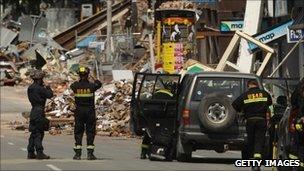Christchurch quake: Dead are buried as weather worsens
- Published
The BBC's Phil Mercer says baby Baxtor Gowland was one of two babies killed in the tragedy
The New Zealand city of Christchurch has begun to bury its dead following last week's devastating earthquake.
The first service was for the youngest victim so far - baby Baxtor Gowland, born just after last September's quake.
The death toll from 22 February is now 148 people; only eight bodies have been released for burial so far.
Rescue teams continue to search for survivors but aftershocks have hampered their efforts and a forecast windstorm could add to the hazards they face.
No survivors have been rescued since mid-afternoon on Wednesday.
The opening of new cracks in a cliff overlooking some outer suburbs and continuing aftershocks have kept residents nervous.
People are still trying to leave the city following the magnitude-6.3 earthquake that wrecked the centre of the city.
Young Baxter Gowland was one of two infants named as casualties in the quake. He was killed by flying masonry as he slept at home.
His family and friends gathered at a chapel for a service at which a slideshow of his short life was shown.
It was the first of several services to come; on Tuesday two minutes' silence will be held to commemorate the victims, a week after the earthquake struck.
'Blitz'
Former New Zealand Prime Minister Helen Clark said the country had "suffered a tragedy of monumental proportions".
"The building damage I've seen compared with Haiti," she told Radio New Zealand, in a reference to the massive quake that killed at least 220,000 there in January last year.
"It's going to require every ounce of recovery in this country to push through from this," she added, after a visit to Christchurch on Sunday.

Many residents have chosen to leave Christchurch while the process of reconstruction gets under way
Prime Minister John Key says the cost of the quake is expected to reach NZ$20bn ($15bn, £9.3bn).
He has announced an initial NZ$120m package of subsidies that will pay the salaries of those who cannot return to work because of the damage caused by the earthquake.
He said there was still a glimmer of hope survivors could be found, but rescuers working for a sixth day found only bodies.
Engineers say at least a third of the buildings in the centre of Christchurch will need to be demolished. Hundreds of damaged suburban homes may also have to be pulled down.
Mr Key said the disaster "may be New Zealand's single most tragic event", outstripping a 1931 quake in Napier which killed 256.
For many residents, it is all too much, and there is an exodus from Christchurch, says the BBC's Phil Mercer in the city.
Doctors are reporting a significant increase in mental health problems since the earthquake struck, most notably anxiety and insomnia.
There has also been a sharp rise in the number of people suffering heart attacks, our correspondent says.
Power has been restored to most of the city but water supply remains a problem, with residents being urged to boil water for drinking or cooking because of contamination fears.
The quake struck at a shallow depth of 5km (3.1 miles) last Tuesday lunchtime, when the South Island city was at its busiest.
CLICKABLE Select the images for more details.

Bexley

Streets in the north-eastern suburb of Bexley were flooded as the quake caused water mains to burst, which coincided with heavy rain.
Pyne Gould Guinness

The multi-storey Pyne Gould Guinness Building, which normally houses around 200 workers, collapsed. A number of people were thought to be trapped inside.
Cathedral

The 63m spire of the city's Anglican cathedral was toppled by the earthquake. A New Zealand TV reporter took a look inside the damaged building.
CTV building

Part of Christchurch's Canterbury Television [CTV] building completely collapsed in the earthquake. Some 24 people have been rescued from the building, but police said there might be between 60 and 120 bodies trapped underneath.
Oxford Terrace

In the aftermath of the earthquake, Rhys Taylor took this video on Oxford Terrace, 50 metres away from the city's main hospital. He said: "Cars were being used as ambulances to transport the injured."
- Published28 February 2011
- Published26 February 2011
- Published25 February 2011
- Published27 February 2011
- Published24 February 2011
- Published23 February 2011
- Published23 February 2011